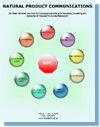Xanthine Oxidase Inhibitory Activity of Some Vietnamese Remedies Used to Treat Bi Syndrome in Traditional Medicine
IF 1.4
4区 医学
Q4 CHEMISTRY, MEDICINAL
引用次数: 0
Abstract
BackgroundHyperuricemia is a metabolic disorder caused by abnormalities in purine metabolism that increase serum uric acid. Some traditional medicine remedies have been proven to cause hypouricemia by inhibiting xanthine oxidase. In Vietnam, some remedies that eliminate wind, cold, and dampness have been used to treat gouty arthritis, but there is still a lack of scientific evidence regarding the underlying biological mechanisms involved. This study aimed to assess the xanthine oxidase inhibitory activity in vitro and the hypouricemic effects of several Vietnamese remedies used to treat Bi syndrome in traditional medicine.MethodsThe chosen remedies that met our criteria were successively extracted with 70% ethanol. A preliminary investigation of the chemical composition of the extracts was performed by common chemical reactions. The in vitro xanthine oxidase inhibitory activity of the extracts was investigated using the procedure of Noro et al (1983). Acute toxicology and hypouricemic effect of the remedy that showed the highest xanthine oxidase inhibitory activity were investigated in vivo using a potassium oxonate-induced hyperuricemic mouse model.ResultsFive remedies that met the criteria were chosen. Phytochemical screening of all the extracts revealed the presence of flavonoids, saponins, alkaloids, tannins, and carbohydrates. The Bai nghiem phuong 2 extract did not show xanthine oxidase inhibitory activity whereas the Thang Tri Te Thap extract, which exhibited the highest inhibitory xanthine oxidase activity with an IC传统医学中用于治疗毕氏综合征的一些越南草药的黄嘌呤氧化酶抑制活性
背景高尿酸血症是由于嘌呤代谢异常导致血清尿酸升高而引起的代谢紊乱。一些传统药物疗法已被证实可通过抑制黄嘌呤氧化酶引起高尿酸血症。在越南,一些祛风、祛寒、祛湿的药方已被用于治疗痛风性关节炎,但有关其中潜在的生物机制仍缺乏科学证据。本研究旨在评估越南传统医学中用于治疗毕氏综合征的几种药方的黄嘌呤氧化酶体外抑制活性和降尿酸作用。通过普通化学反应对提取物的化学成分进行了初步研究。采用 Noro 等人(1983 年)的方法对提取物的体外黄嘌呤氧化酶抑制活性进行了研究。采用氧化钾诱导的高尿酸血症小鼠模型,对黄嘌呤氧化酶抑制活性最高的药方的急性毒理和降尿酸作用进行了体内研究。对所有提取物进行的植物化学筛选显示,其中含有黄酮类、皂苷、生物碱、鞣质和碳水化合物。Bai nghiem phuong 2 提取物未显示黄嘌呤氧化酶抑制活性,而 Thang Tri Te Thap 提取物显示出最高的黄嘌呤氧化酶抑制活性,IC50 值为 48.33 ± 0.41 µg/mL,因此被选中用于随后的体内实验。Thang Tri Te Thap 提取物不会引起急性毒性,其最大剂量为 31.67 克/千克。在剂量为 1.5 g/kg 和 3 g/kg 时,Thang Tri Te Thap 可显著降低血清尿酸浓度,分别为 59.84 ± 5.79% 和 65.01 ± 12.73% (p < 0.05)。
本文章由计算机程序翻译,如有差异,请以英文原文为准。
求助全文
约1分钟内获得全文
求助全文
来源期刊

Natural Product Communications
工程技术-食品科技
CiteScore
3.10
自引率
11.10%
发文量
254
审稿时长
2.7 months
期刊介绍:
Natural Product Communications is a peer reviewed, open access journal studying all aspects of natural products, including isolation, characterization, spectroscopic properties, biological activities, synthesis, structure-activity, biotransformation, biosynthesis, tissue culture and fermentation. It covers the full breadth of chemistry, biochemistry, biotechnology, pharmacology, and chemical ecology of natural products.
Natural Product Communications is a peer reviewed, open access journal studying all aspects of natural products, including isolation, characterization, spectroscopic properties, biological activities, synthesis, structure-activity, biotransformation, biosynthesis, tissue culture and fermentation. It covers the full breadth of chemistry, biochemistry, biotechnology, pharmacology, and chemical ecology of natural products.
Natural Product Communications is a peer reviewed, open access journal studying all aspects of natural products, including isolation, characterization, spectroscopic properties, biological activities, synthesis, structure-activity, biotransformation, biosynthesis, tissue culture and fermentation. It covers the full breadth of chemistry, biochemistry, biotechnology, pharmacology, and chemical ecology of natural products.
 求助内容:
求助内容: 应助结果提醒方式:
应助结果提醒方式:


